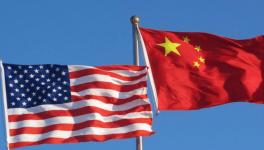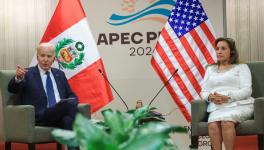India Shouldn’t Align With Five Eyes
The Five Eyes has been in the vanguard of Hong Kong protests
Against the backdrop of border tensions in Ladakh, the Indian media narratives have ascribed to our foreign-policy lurch toward the Quad and the overall tilt to the US, the breakdown of mutual trust in India-China relations. Chinese statements have repeatedly expressed regret that their expectations out of the consensus reached at the leadership level (in Wuhan and Chennai Connect) have been belied — that neither side would regard the other as rival.
However, the Indian narratives failed to take note that the proximity that has developed between Delhi and Canberra also has a cutting edge for China’s security in the recent years since 2014 when the two sides signed the Framework for Security Cooperation “to guide closer bilateral collaboration across the security spectrum”.
The point is, we think of Australia as a laid-back sidekick of the US in the western Pacific, famous for cheese and cricket. In reality, though, Australia plays an irreplaceable role in the Anglo-American regional strategies directed against China.
Australia belongs to the Five Eyes, the core of the western intelligence system comprising three rings. Enveloping the Five Eyes is a ring known as the Nine Eyes and an outer ring called Fourteen Eyes. This is like peeling an onion; when you reach the bulb, you finally spot the Five Eyes (which comprises the US, Britain, Canada, Australia and New Zealand).
The Five Eyes arose out of a cold war era pact called the UKUSA Agreement, an exclusive intelligence-sharing agreement aimed at decrypting Soviet intelligence traffic. By the late 1950s, Canada, Australia, and New Zealand also joined the Anglo-American intelligence system. These five English-speaking countries make up the Five Eyes Alliance as we know it today.
Their intelligence-sharing agreement has only strengthened over time, notwithstanding the collapse of the Soviet Union and the end of the Cold War. In fact, the very existence of the super-secret Five Eyes came to be known only in 2003. Thanks to Edward Snowden, we are much wiser since 2013.
The Nine Eyes and Fourteen Eyes Alliances are essentially extensions of the original Five Eyes Alliance. While these countries may not all share as much information with each other as the Five Eyes Alliance, they still actively and willingly participate in international intelligence-sharing.
Suffice to say, any whichever way one looks back at the optics of the India-Australia virtual summit on June 4, it was an appalling event. The timing was simply awful — bang in the middle of the India-China standoff and the suspended animation in Hong Kong due to Covid-19.
The Indian-Australian summit carried much symbolism. The truly intriguing part is how the PM Modi’s aides could have been indiscreet by scheduling such an event even as tensions were cascading in the Himalayas! Conceivably, US state secretary (and ex-CIA Director) Mike Pompeo would have promoted the idea?
Now, Hong Kong has been a playpen of the Five Eyes. From all accounts, Australian intelligence has been in the vanguard of the intelligence operation by the Five Eyes to create mayhem in Hong Kong. The Chinese Foreign Ministry spokesman made copious references to it in the recent days. Some excerpts:
“We urge the US side to grasp the situation, abide by international law and basic norms of international relations, stop interfering in Hong Kong affairs through any means… Otherwise, China will react strongly and the US shall bear all consequences… The reason why Mr. Pompeo and his like make such a fuss about the Law (enacted recently for Hong Kong) is that they won’t be able to jeopardise China’s sovereignty and security in as reckless and unchecked ways as before. The Law is like a burglar-proof door for Hong Kong.”
Alas, there have been media reports linking Indian security agencies to the western covert operations in Hong Kong to destabilise China. India doesn’t belong to the Five Eyes and, therefore, the veracity of these reports is questionable, perhaps. But they create misperceptions.
One such report actually said that business establishments of the thriving NRI community in Hong Kong were misused as secret venue for meetings with the student-protestors on rampage. (If true, it was reprehensible to jeopardise the businesses of the thriving Indian community in HongKong numbering in lakhs.) At least one Indian TV channel deputed a team from Delhi all the way to Hong Kong to bring the anti-China protests right into our living rooms.
Hong Kong, Taiwan, Tibet, Xinjiang — these are core issues of China’s internal security. No country allows foreign ingresses into such sacred turf of national sovereignty and territorial integrity. Unsurprisingly, Beijing has moved in with all the national grit and political will at its command, after watching with a semblance of helplessness for well over a year the western intelligence’s rampage in Hong Kong.
Beijing means business. According to reports, China’s Ministry of State Security, the foremost intelligence and political security agency, has formally opened an office in Hong Kong this week. To be sure, the Five Eyes get the point that the endgame has appeared.
The Foreign Ministers of the Five Eyes confabulated on Wednesday to discuss the emergent situation in Hong Kong. Canada, UK and Australia have announced plans to relax their visa restrictions selectively for people from Hong Kong. Under the guise of humanitarian gesture, a covert evacuation plan is being mounted to spirit away the agents and accomplices of the Five Eyes out of China to live and fight another day. (here and here)
Clearly, President Xi Jinping’s phone call to Russian President Vladimir Putin on Wednesday can be seen in this context. Xi pointedly referred to the criticality of China-Russia cooperation in countering “external sabotage and intervention” in the two countries’ internal affairs.
The Kremlin readout underscored, “The presidents expressed firm mutual support in protecting sovereignty, preventing any interference in internal affairs from outside and ensuring the supremacy of international law.” (See my blog Russia, China keep the ‘dragon in the fog’.)
India should tread warily. It is with a game plan to complicate India-China relations that ex-CIA Director Pompeo has drawn India recently into a new ginger group of foreign ministers, ostensibly to discuss post-pandemic issues. Hopefully, Delhi understood what (ex-CIA Director) Pompeo is up to. EAM Jaishankar sounded exuberant over Pompeo’s initiative, tweeting “Look forward to continuing this engagement.”
Apart from Pompeo and EAM Jaishankar, this nascent ginger group includes the foreign ministers of Israel, Japan and South Korea. Now, these 3 countries (plus Singapore) also happen to be “third-party contributors” to the Five Eyes — associate members who have been caught or are suspected of exchanging information with the Fourteen Eyes Alliance. Does India belong to such a group? We should introspect seriously, EAM’s enthusiasm for the Pompeo iniitiative notwithstanding.
In retrospect, what began in 2014 as an innocuous India-Australia security agreement to embellish PM Modi’s visit to Australia has acquired habitation and a name. But how far does it serve India’s interests to align with an outrider of the West in the Asia-Pacific? Was it of any meaningful use in Eastern Ladakh? A cost-benefit analysis is needed.
Get the latest reports & analysis with people's perspective on Protests, movements & deep analytical videos, discussions of the current affairs in your Telegram app. Subscribe to NewsClick's Telegram channel & get Real-Time updates on stories, as they get published on our website.























